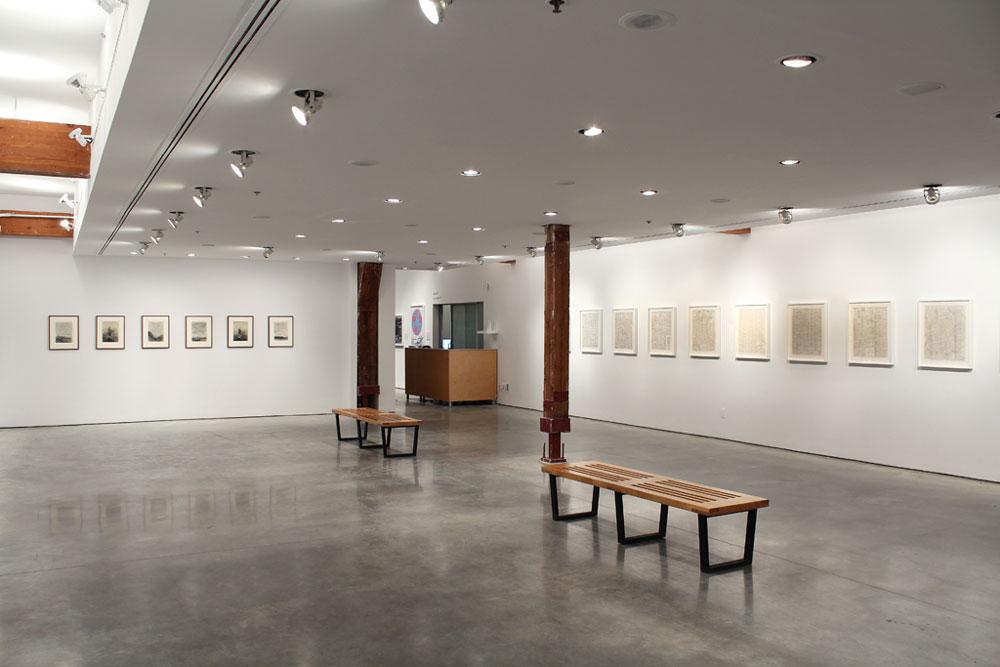Neil Wedman’s new exhibition at the Charles H. Scott Gallery—“Selected Monochromatic Paintings and Works on Paper, Part Two of Two”—contains three bodies of work: three oil paintings that depict volcanoes, titled Underwater Volcanoes #4, 5, 6 (2012); a series of 12 India ink and pencil drawings of newspapers, titled Newspapers #1–12 (2011); and a series of 24 conté sketches, titled Untitled (Flying Saucers & Underwater Volcanoes) (2010–11). This important show (which follows on a “Part One” at Equinox Gallery last January) has much to say about contemporary image production, art history and technique.
To begin with Wedman’s approach to technique: His large drawings of newspaper pages are roughly the size of the eight-column spreads from a 1929 copy of the New York Times that he has collected. These drawings reproduce not the words of the newspaper, but their shapes: the rectangles and lines that a newspaper would read as via a blurred glimpse.
Here, headlines and subheads, bylines and groupings of words in paragraphs are reduced to squares and rectangles. These are different shades of grey and black, as if not merely the words were out of focus, but also their tonality. The ink wash ages the paper as if to simulate the historical datedness of these newspaper pages—or their general usefulness as a media format—in our contemporary digital epoch.
In a similar fashion, the conté sketches of UFO sightings (Wedman has been working with such imagery for more than a decade) are extremely fine, with the weave of the paper showing through the stippled texture of the drawings. As much as their drawn quality is evident, they also remind me of a different medium—photography—but only because photography, altered or otherwise, has provided the main means of “depicting” UFOs in popular culture.
At the opening, artist Tim Lee declared Wedman’s UFO drawings to be in the style of Georges Seurat—which Wedman acknowledged—and one can see the pointillist’s mastery of technique and tonal range in these sketches. As with the newspaper drawings, we have a blurred effect, this time of the pot-lid or flying-saucer shapes against a night sky. The UFO works also pair nicely with the drawings of underwater volcanoes; discussing the exhibition in the gallery a few days after the opening, Wedman noted that these drawings continue his interest in the invisible.
In other regards, Wedman’s sketches are even more Seurat-like. MoMA curator Jodi Hauptman has argued that Seurat’s subject matter—everyday street life—and materials of laid paper and conté led him to “an extradordinary discovery: that modernity is not served by the contour line.”
Similarly, Wedman’s drawings dispense with line, going all-out for the monochromatic, letting the laid pattern and chain lines of his paper (which is not, like Seurat’s, handmade, but is machine-watermarked) do battle with barely-there glimpses of UFOs or volcano steam. Sometimes the UFO is a squib of white of the paper’s surface; sometimes grey or black; sometimes, the plume of steam from an underwater volcano rises to concentric circles on the water’s surface with all the heroic force of one of Emily Carr’s trees broaching the atmosphere. Whatever phenomenon is depicted, the shift from ground to figure is rarely absolute, and it is rarely marked as such.
Wedman’s technical prowess is also evident in the large oil paintings which sit at one end of the gallery. They almost seem to preside at the head of a table, with the newspaper drawings ranged down one side and the UFO sketches down the other.
In these paintings, ejaculatory beams of light—or lava—anchor the canvas, while steam or grit circulates throughout the surface, with more concentric circles depicted at the top. But here—besides the artistry evident in the subtle effects of steam and water—Wedman has also applied a wonderful splatter of small grey or silver sparkles which are made by dropping rubber cement onto the surface as masking and then removing it in different stages.
The effect of this rubber-cement technique conjures not so much Seurat’s dots, but rather, as Wedman has said, something more akin to the Ben-Day dots in Roy Lichtenstein’s drawings and paintings. The iridescent blobs seem to move, to leave behind trails in the water—or perhaps these smudges are shadows.
Such uncertainty, in the end, is surely the point of Wedman’s exhibition.
The newspaper works are not about reading, but about the geometric structure of old newspapers, and of the media’s past. Images of flying saucers no longer circulate with credibility, marginal or otherwise, since the advent of Photoshop. And underwater volcanoes, a paradox of fire and water, are usually invisible to us. Indeed, the volcano paintings may return us to the newspaper drawings, as Ben-Day dots evoke the printing techniques associated with pulp comics.
Because there is much that we cannot see in this show, we have to come close to the works, to their paper or their canvas. It is this coming close that matters, and that makes the material and the media, the paper and the conté, a part of our present day—even as we are told that these media, like so many others, are quickly fading into irrelevance.









